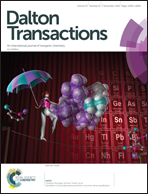N-Alkyl calix[4]azacrowns for the selective extraction of uranium†
Abstract
The selective extraction of uranium by N-octylcalix[4]azacrown (NOCAC) and N-ethylhexylcalix[4]azacrown (NEHCAC) was investigated. The ligands were synthesised in three steps through the functionalisation of t-butyl calix[4]arene at the distal-1,3-positions of the lower rim with ethyl acetate groups followed by cyclisation with (imino)bis(ethane-2,1-diyl)diamide. A detailed investigation on the effect of various parameters, such as the aqueous phase acidity (sulfuric acid), the ionic strength, and ligand concentration, on the extraction of uranium(VI) has been conducted. The effect of the H2SO4 concentration has been studied from 0.02 to 3 M. Preliminary studies carried out on NOCAC in dodecane/octanol diluents showed that the uranium extraction from sulfuric acid is more efficient at a low H2SO4 concentrations. The stoichiometry of complexation was estimated from the slope method, NMR titration, and electrospray ionisation-mass spectrometry analysis. Both ligands were found to be highly selective for uranium(VI) over other competitive cations present in a simulated leach solution containing seven competitive cations. The successful recovery of the uranium from the organic phase has been performed thanks to stripping steps involving ammonium oxalate, ammonium carbonate, and sodium carbonate as stripping agents.
![Graphical abstract: N-Alkyl calix[4]azacrowns for the selective extraction of uranium](/en/Image/Get?imageInfo.ImageType=GA&imageInfo.ImageIdentifier.ManuscriptID=C8DT03140A&imageInfo.ImageIdentifier.Year=2018)


 Please wait while we load your content...
Please wait while we load your content...